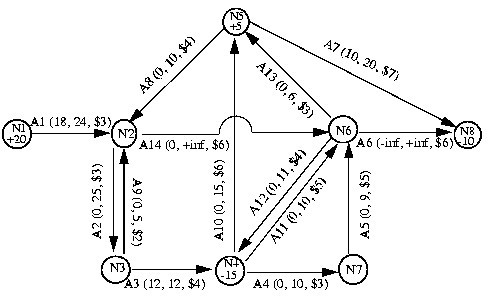CPLEX Appendix E
|
This page is part of the CPLEX Manual. See CPLEX. |
TOMLAB /CPLEX Network Solver
The TOMLAB /CPLEX network solver is a special interface for network problems described by a set of nodes and arcs. The TOMLAB format is not applicable for these types of problem. See cplexnet for information on calling the solver.
A network-flow problem finds the minimal-cost flow through a network, where a network consists of a set N of nodes and a set A of arcs connecting the nodes. An arc a in the set A is an ordered pair (i, j) where i and j are nodes in the set N; node i is called the tail or the from-node and node j is called the head or the to-node of the arc a. Not all the pairs of nodes in a set N are necessarily connected by arcs in the set A. More than one arc may connect a pair of nodes; in other words, a1 = (i, j) and a2 = (i, j) may be two different arcs in A, both connecting the nodes i and j in N.
Each arc a may be associated with four values:
- xa is the flow value, that is, the amount passing through the arc a from its tail (or from-node) to its head (or to-node). The flow values are the modeling variables of a network-flow problem. Negative values are allowed; a negative flow value indicates that there is flow from the head to the tail.
- la the lower bound, determines the minimum flow allowed through the arc a. By default, the lower bound on an arc is 0 (zero).
- ua, the upper bound, determines the maximum flow allowed through the arc a. By default, the upper bound on an arc is positive infinity.
ca, the objective value, determines the contribution to the objective function of one unit of flow through the arc.
Each node n is associated with one value:
- sn is the supply value at node n.
By convention, a node with strictly positive supply value (that is, sn > 0) is called a supply node or a source, and a node with strictly negative supply value (that is, sn < 0) is called a demand node or a sink. A node where sn = 0 is called a transshipment node. The sum of all supplies must match the sum of all demands; if not, then the network flow problem is infeasible.
Tn is the set of arcs whose tails are node n; Hn is the set of arcs whose heads are node n. The usual form of a network problem looks like this:
Failed to parse (unknown function "\multicolumn"): {\displaystyle \begin{array}{rccccl} \min\limits_{x} & \multicolumn{5}{l}{{\sum\limits_{a \in A}c_{a}x_{a}}} \\ & \\ s/t & \multicolumn{5}{l}{\sum\limits_{a \in T_a}x_{a} - \sum\limits_{a \in H_a}x_{a} = s_{n} \forall n \in N}\\ & l_{a} & \leq & x_{a} & \leq & u_{a} \\ \end{array} }
A test routines that illustrates a simple problem is included in the TOMLAB distribution. <xr id="fig:netProblem" /> shows the network problem solved:
The following code will call the network solver and deliver the optimal solution.
<figure id="fig:netProblem">
</figure>
x = cpxNetTest1;
It is possible to call the TOMLAB /CPLEX solver using a special non-MATLAB input format. Example cpxNetTest2 illustrates how to load and solve the problem described in nexample.net.
